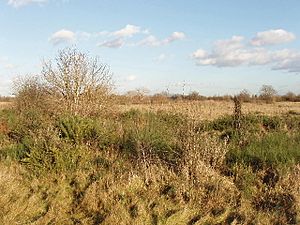Hounslow Heath facts for kids
Quick facts for kids Hounslow Heath |
|
|---|---|
 |
|
| Lua error in Module:Location_map at line 420: attempt to index field 'wikibase' (a nil value). | |
| Location | Hounslow |
| Nearest city | London |
| OS grid | TQ1274 |
| Area | 82 hectares (200 acres) |
| Operated by | London Borough of Hounslow |
| Status | open all year |
| Hiking trails | Crane Valley Walk (London Loop) |
| Habitats | Heathland |
| Designation | Local Nature Reserve |
| Parking | A315 Staines Road |
| Public transit access | Buses: 237, 116, 117, 235, 635 Hounslow West tube |
| Other information | Telephone: 08454562796 |
Hounslow Heath is a large, open green space in Hounslow, London. It's a special place known as a Local Nature Reserve, which means it's protected for its wildlife and natural beauty. This area covers about 200 acres (80 ha) and is all that's left of a much bigger historic heath that once spread over 4,000 acres (1,600 ha). Today, Hounslow Heath is bordered by busy roads like the A315 Staines Road and the River Crane. It's a great spot for walks and exploring nature.
Contents
A Look Back: The History of Hounslow Heath
How Big Was the Original Heath?
The original Hounslow Heath was huge! It was a type of land called heathland and covered many areas that are now separate towns and parts of London. These included places like Feltham, Hampton, Heston, and even where Heathrow Airport is today.
Ancient Roads and Armies
Hounslow Heath has always been an important place, especially for travel. Main roads from London to the west and southwest of Britain crossed it. For example, the A315 Staines Road, which is now the northern edge of the heath, was once a Roman Road called Via Trinobantes. There are old stories and records about Roman camps being set up on or near the heath.
Later, armies used the heath because it was close to London, Windsor Castle, and Hampton Court Palace. In 1647, during the English Civil War, Oliver Cromwell's army camped here. Much later, in 1793, Hounslow Barracks was built nearby to help protect against a possible French invasion.
Highwaymen and Mapping Britain
In the 17th and 18th centuries, Hounslow Heath was famous for being a place where highwaymen and footpads hid. These were robbers who would stop travelers on the main roads, like the Great West Road and the Bath Road, to steal their money and belongings.
The heath also played a key role in mapping the whole of the United Kingdom! The first accurate measurements for the Ordnance Survey (the official map-making agency) began on Hounslow Heath. It was chosen because it's very flat and close to the Royal Greenwich Observatory. This work helped create the detailed maps we use today.
From Training Ground to Airfield
Around 1900, Hounslow Heath was still used by the army for training cavalry (soldiers on horseback) and for shooting practice. When World War I started in 1914, Hounslow Heath Aerodrome was built here. This became an important base for fighter planes and training pilots.
In 1919, something very special happened: this aerodrome became London's main airport for international flights! It hosted the first regular daily international flights. However, its airport role didn't last long, and in 1920, a new airport, Croydon Airport, took over. The heath then went back to being used for military training.
Remembering the First Flight to Australia
On the north side of the heath, near Staines Road, there's a monument that remembers an amazing journey. It's for the first England to Australia flight! In 1919, two Australian brothers, Keith and Ross Smith, took off from Hounslow Heath Aerodrome in a modified plane called a Vickers Vimy. They flew all the way to Darwin, Australia, arriving in December that year. A plaque also marks the entrance to what was London's first civil airport.
Modern Changes to the Heath
After World War II, some parts of the heath were used to dig up gravel. Later, this land was used for landfill (burying rubbish) until the late 1960s. But then, the land was cleaned up and turned into the Hounslow Heath Golf Centre, which opened in 1979.
Uncovering the Past: Archaeology at Hounslow Heath
Archaeologists have found many interesting things around Hounslow Heath. For example, Bronze Age spearheads, axes, and pieces of swords and knives have been discovered here. Even Celtic badges and amulets were found in a field in 1864!
More recently, in 1999, during excavations near the heath, workers found parts of an Iron Age furnace and holes where posts for a round house once stood. Along the River Crane near the heath, there are also remains of old mills and other industrial sites. This part of the river is so important for history that it's called an Archaeological Priority Area.
A Haven for Wildlife: Hounslow Heath Nature Reserve
Hounslow Heath is officially a Local Nature Reserve and a "Site of Metropolitan Importance for Nature Conservation." This means it's a very important place for wildlife in London.
The heath has many different types of natural areas:
- Lowland Heath: Open areas with heather and tough grasses.
- Dry Acid Grassland: Grassy areas that are dry and have acidic soil.
- Woodland and Scrub: Areas with trees and bushes.
- Neutral Grasslands: Different types of grassy fields.
- Wetlands: Areas that are wet, like marshes or bogs.
- Wildflower Meadows: Fields full of colorful wildflowers.
All these different habitats make Hounslow Heath a wild and rugged place with lots of paths for exploring. It's a fantastic spot to see different plants and animals right in the city!



